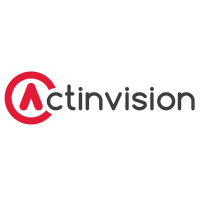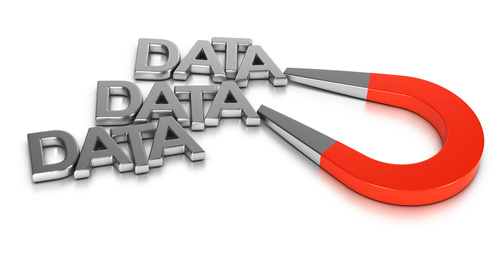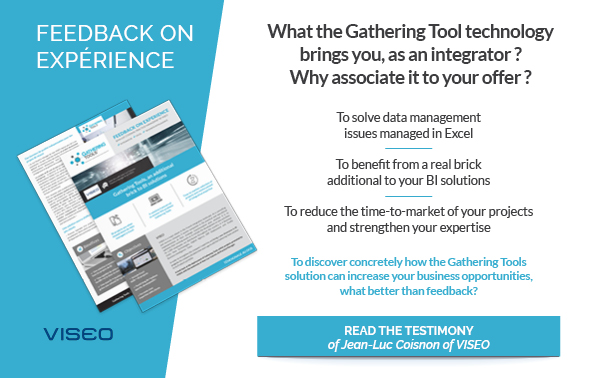Interview with Olivier Catherin, CEO, and co-founder of Actinvision
 Actinvision is a Business Intelligence specialist for data analysis and visualization. Our ambition is to enhance the information heritage of our customers. The services we offer cover the entire value chain of the data, from its preparation to the implementation of solutions that are dedicated to the visualization of information.
Actinvision is a Business Intelligence specialist for data analysis and visualization. Our ambition is to enhance the information heritage of our customers. The services we offer cover the entire value chain of the data, from its preparation to the implementation of solutions that are dedicated to the visualization of information.
It is precise to better meet the needs of data collection that Actinvision has looked at the “birthplace” of Gathering Tools and decided, almost 4 years ago, to form a partnership with the publisher.
The existence of Excel within companies
 Data management IT projects thrive within companies to be more efficient everyday tasks, to provide the right information at the right time to the right person, and to consolidate data and make the right strategic decisions. In short, it is not something new, we are in the era of Data Governance.
Data management IT projects thrive within companies to be more efficient everyday tasks, to provide the right information at the right time to the right person, and to consolidate data and make the right strategic decisions. In short, it is not something new, we are in the era of Data Governance.
The CIO plays a key role in the classification of projects. Indeed, it is him who is in charge of analyzing, benchmarking and deploying the “right” solutions, while ensuring the overall consistency of the Information System. It goes without saying that Excel is not one of those so-called solutions while having problems of security, integrity and data loss.
And yet, in spite of the good advice of their IT leaders, the businesses inevitably continue to capitalize, consolidate and share an impressive amount of data via Excel. Why? Simply because this tool is full of advantages such as it is easy to use, easy to adapt, and easily customise without the help of a developer, etc.
The Business Intelligence specialists are unanimous, confessing that Excel is a gold mine of data “field” unavoidable and complementary to those existing within the Information System. This data must, therefore, be taken into account and collected in order to transform data into actionable, fair and reliable information.
Complex and expensive collection processes
 To address this problem, which is strongly ingrained in IT departments, two main approaches are generally preferred.
To address this problem, which is strongly ingrained in IT departments, two main approaches are generally preferred.
The first option, the implementation of business solutions such as management software for collecting financial data. These solutions offer the advantage of meeting very specific needs while natively providing the necessary gateways to the Central Information System. However, investment costs (licenses), hosting, deployment or even maintenance can quickly increase the rating. Moreover, these solutions never perfectly fit the specific needs of everyone. Finally, their implementation requires a conductive change.
As you can see, the business solutions can quickly become time consuming and expensive, without necessarily receiving the support of businesses. Therefore, there is a good chance that Excel comes back through the back door.
The second option, the specific development. This ensures that your data collection fits perfectly with the needs and processes of the company and that the gateways to the IS are done “once and for all”. The CIO will then have in hand a “perfect” tool, which will probably collect the favorable opinions of businesses. But at what cost? At the cost of, initial development, corrective maintenance, and budgets related to the evolution and not to mention the deadlines for implementation. These constraints will soon discourage the CIO, that will negatively affect how Excel is perceived?
There is, however, an alternative!
Gathering Tools, the missing brick.
 As a BI expert, we have often been confronted with the problem of consolidating data from different Excel sources. That’s why we were amazed by the Gathering Tools approach.
As a BI expert, we have often been confronted with the problem of consolidating data from different Excel sources. That’s why we were amazed by the Gathering Tools approach.
This solution is for us a way to “reconcile” CIO and people in the business sector. The tool does not come in replacement but an improvement of the existing one. The trades thus preserve their work habits, Gathering Tools coming to be modeled on Excel in all transparency. The CIO, on the other hand, benefits from the power of an agile and secure environment, in which data integrity and consistency are ensured.
Gathering Tools makes it possible to trace the 20% of data not managed by the “Official” Information System. This highly strategic field data thus contributes to strengthening the power of Business Intelligence by offering our customers the right indicators and a real 360 ° vision. In my opinion, this is an additional-essential brick to BI, which really supplements the shortcomings of other products.




